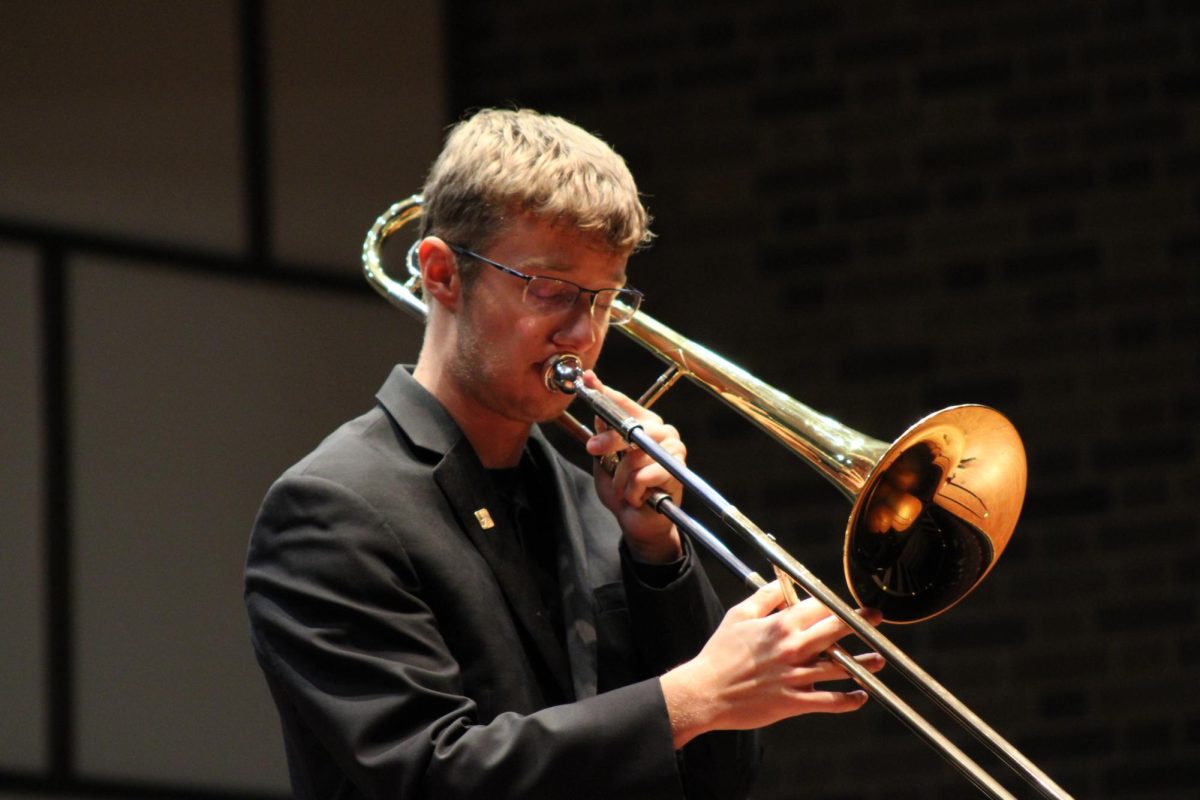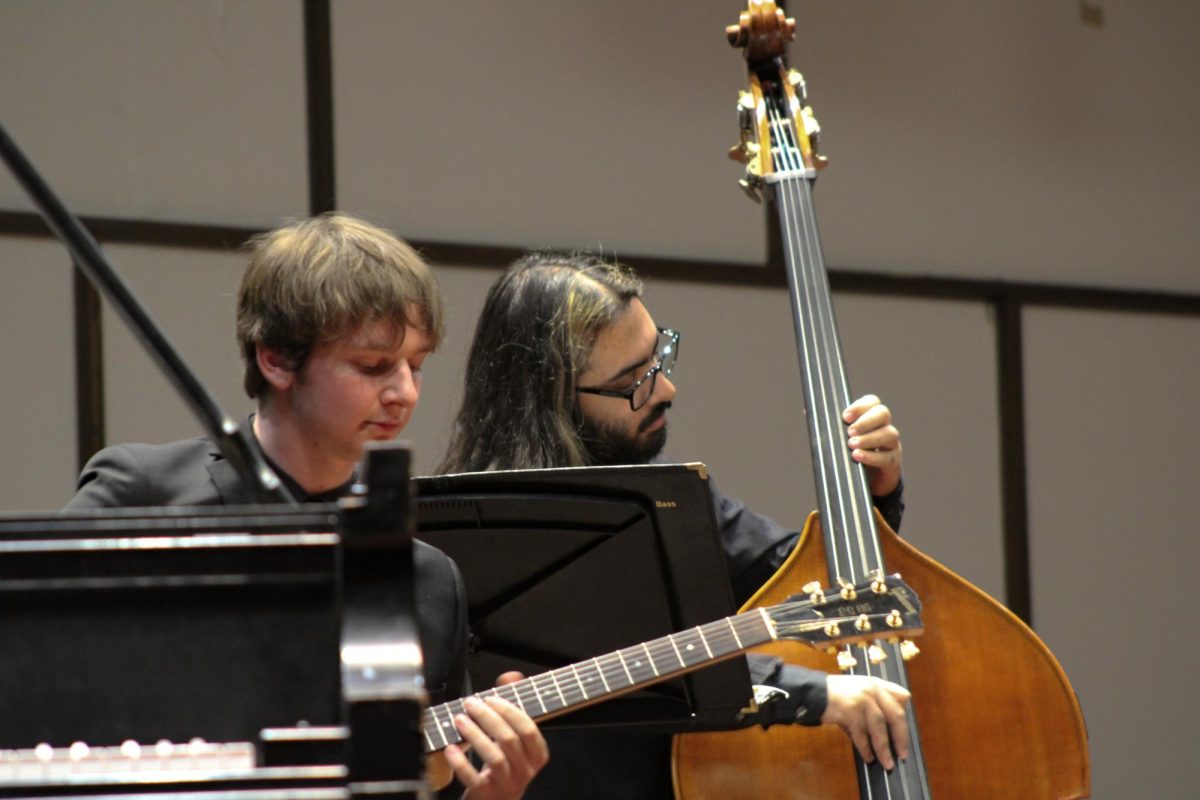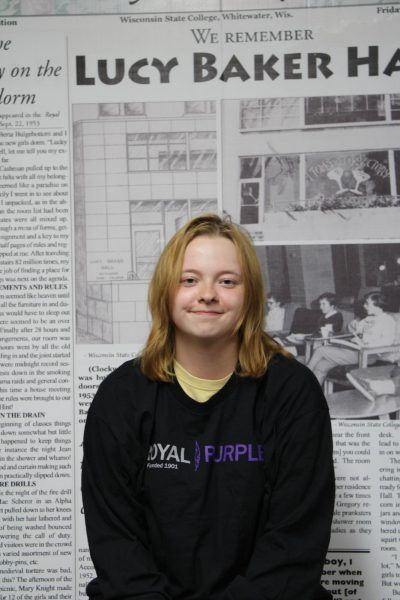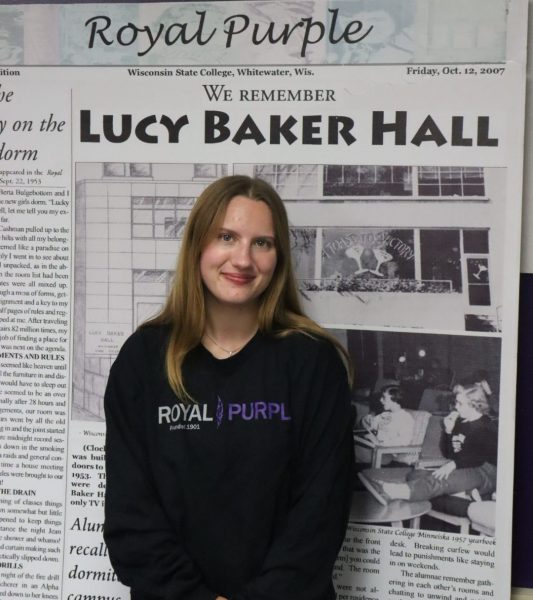When a musician performs on stage, whether solo, in an ensemble or as part of a combo group, we usually appreciate the art they have worked hard to craft into a beautiful story unraveling around them. Audiences rarely think about what a musician felt after their performance, whether nervous, excited or relieved. Unless they know the musician, they usually did not ask a musician how the performance went. Come and explore the minds of the musicians who played in the Jazz Combo Concert and how they felt before and after their concert finished.
The first combo to perform was Jazz Combo Three, which featured saxophone, piano, bass and drums. The second combo included trumpet, flugelhorn, trombone, piano, bass and drums. The last group to perform was Combo One, which consisted of trombone, guitar, piano, bass and drums.
The concert program ranged from classic jazz standards to pieces composed and debuted by students that night. Here is a look at the thoughts of the musicians before and after their performance.
Jazz Combo Three
“I find improvisation to be the hardest thing in the concert since there is no set way to form your voice,” said saxophonist Adriel Correa.
Correa had been very excited to perform in the concert and to display his improvement in jazz. He was also excited to listen to the upper jazz combos and see what they improvised, as well as how they communicated on stage.
“My only challenge in preparing for the combo concert was working with our drummer and making sure we were staying together as a group. Since I am doing baselines, I don’t find any other challenging aspects in practice,” said bassist Nolan Warner.
Warner was excited to get back into performing on stage and to play in front of an audience. He expressed how much practice he put into the music to sound good once the big night came.
“Our piece ‘St. Thomas’ was the hardest piece for me. It has swing elements in the drums and different themes throughout the piece. I am learning how to figure out solos and how to set up the soloists and help them through their improvisation,” said drummer Ethan Horton.
Horton had been excited to play the drums and jazz tunes in front of an audience. He was also excited to see other combos play their tunes.
After the concert, Warner said, “One of the biggest things that could’ve improved was preparing to talk in front of the audience. We didn’t plan for it, and we winged it since we weren’t ready or prepared.”
Warner learned that he has improved in going through the motions and with the flow of the music. He expressed that when the pianist in the group changed the style a bit, he automatically went with him even though he wasn’t prepared for it but was able to get back into the groove with the pianist.
“I had gotten nervous before going on stage, especially while performing. I let the nerves get to me and I didn’t reach the goals I previously set for myself,” Correa said. “But it was my first combo performance, and although I didn’t do as well as I wanted, I will have other chances. I know the next performance, I’ll hit 10 times harder.”
Correa thought that everyone was able to keep track of the form of each song and stay together as a combo, even when a mistake was made.
Jazz Combo Two
“Improvisation is the most challenging aspect for me, it is cool when it happens because you are making music out of nothing but changes on a sheet of paper,” said bassist Jack Walker.
Walker described how excited he was to listen to Combo One and how cool it would be to see them perform and what they came up with. He believed his combo group would sound good on concert night since they already sounded good in practice.
“My biggest challenge was keeping the form of the piece and responding to soloists at the moment and helping guide them through the bars that they have to solo on,” said drummer Jeremy Boutin.
Boutin expressed his excitement about hearing his combo members’ solos and learning how to accentuate their styles during their solo performances.
“Something that went well for the performance was keeping the tempo and not slowing down. I thought we could improve on dynamics during solos, and as a rhythm section, we could match those dynamics,” Boutin said.
Boutin mentioned he also learned how to recover from fluctuations or mistakes from the group during a tune. He thought the interactions with soloists went well since he found out where to fill in by adding rhythmic choices.
“I have learned a lot about walking bass lines and how to sound interesting without taking the focus away from the lead player,” Walker said.
Walker added how he and his combo have improved on communication and how the rhythm section goes better at working with soloists at the moment to help bring out their solo and add more to them.
Jazz Combo One
“The most challenging aspect in preparing for the tunes on the concert is my sound. I don’t always like my sound during rehearsal and improvising can be challenging in general,” said trombonist Trevor Haglin. “I want to showcase my improvisation and vocabulary of jazz since I have to put my best stuff forward, but I am not concerned with my combo group since we share a strong connection and we learn from each other at the moment.”
Haglin had been excited to play in a combo with his friends, show off his improvisation skills and showcase the music he could create since jazz isn’t the most dominant field in the Center of the Arts. He hoped to bring inspiration to the other combos and people listening in the crowd to dive into jazz.
“The challenging aspect of the concert was preparation since I decided to write my charts and have them showcased in the concert for the first time,” said drummer Devon Powers. “Knowing my parts by listening to recordings and having the components of writing a full story for the audience to listen to. My health has been a big concern since I injured my foot, but it’s doing ok and I’m not trying to over-push myself.”
Devon Powers had been excited to debut his pieces that he wrote as well as being a part of the last performance for some of the musicians on stage. He was also excited to hear another member’s original work being played for the first time. He hoped to stay in prime condition to be ready to perform and to make sure he had his charts memorized confidently.
“The most challenging aspect for me was instrumentation and student schedules not lining up. It caused us to pivot and try to look at things from a different perspective,” said guitarist Sean Powers. “I think the pieces this semester have been solid; we had to enhance our sound and build something that we knew we could share with the audience. We knew we could learn from the pieces, but also be proficient enough in the music format to make something special.”
Sean Powers had been excited to perform on stage since he felt very good with his bandmates. He added how they have the confidence and ability to bend the rules of music to make something that is new and inspiring that isn’t common to hear in the classroom. They fed off of each other’s energy and were excited to see what they could make in the moment.
“I have learned that I can’t rely on others to lead the group through a piece, but rather that all individuals have to lead themselves and work as a team to know what’s going on, where they are going, and what needs to be done to support the other players to create art,” Sean Powers said.
Sean Powers added how the night didn’t go as planned as some of the musicians strayed away from the plan that they had originally set in order to make the concert the best that it could be. He learned the skill of being patient and that the saying, “two steps forward and one step back,” will help keep him grounded and continue to fix future problems within the combo.
“I have learned to not go off script when there is a game plan set in motion for the performance,” Devon Powers said.
Devon Powers hopes to come back as a stronger musician through the slight mistakes that were made on the night of the concert.
“Combo is always an opportunity to work on musical communication between me and the small group, which is a great skill to have and develop. Usually one of the most fun to work on,” Haglin said. “It being another performance opportunity, in general, helped me get more practice performing while nervous, which is an ongoing skill that you can only really work on when you are performing.”
Haglin learned to always know the form even when he’s not playing and that the focus isn’t solemnly on him but on the whole group. Haglin added that he wanted to do a better job of remembering the heads of the jazz tune since his memory slipped once or twice while performing. He found it frustrating since he felt it did not represent the jazz program well and that the communication could have improved within the group.
The concert was filled with jazz and the groups did their best in performance; the audience usually can’t catch the slight mistakes that the musicians made on stage unless they are very familiar with the tune. A lot of the audience members were reacting positively to solos and tapping or nodding their heads to the beats.
If you have any interest in joining a jazz combo, reach out to Dr. Michael Hackett about the audition process to get into a jazz combo. If you want to see what other music-related events are happening, check out the Center of the Arts website for more information about upcoming concerts that are ticketed and unticketed.




